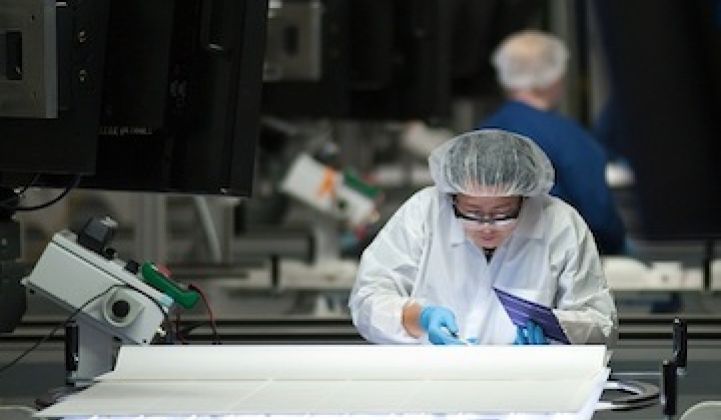Familiar arguments, with just a few new twists, were replayed on Wednesday in Washington, D.C., as U.S. solar manufacturers and their opponents clashed before a commission charged with making the final decision on tariffs on Chinese solar PV imports.
The combatants were testifying before the U.S. International Trade Commission in a hearing [PDF] to determine if alleged unfair practices by the Chinese solar industry -- illegal subsidies from the government and dumping of products at below cost -- are injuring the U.S. industry.
In a preliminary ruling in December 2011, less than two months after SolarWorld and a handful of other U.S. manufacturers petitioned regulators to intervene against the Chinese, the ITC voted 6-0 that there was enough evidence to send the case forward. Since then, preliminary anti-subsidy and anti-dumping tariffs -- totaling around 35 percent on key manufacturers -- have been imposed on Chinese PV imports by the U.S. Commerce Department.
Next week, the Commerce Department will issue its final verdict on the size of the tariffs, and then in early November the ITC is expected to announce its final decision on whether to lock the tariffs into place.
Beleaguered manufacturers told Wednesday’s hearing that things only got worse in the months after the Coalition for American Solar Manufacturing brought the case. The gist of their case: A flood of subsidized, underpriced Chinese imports are bringing American solar manufacturers to their knees.
“Since I testified here last October, Chinese imports have surged into the United States in even greater quantities, far surpassing demand in the market,” Kevin Kilkelly, president of sales for SolarWorld Americas, said in prepared testimony posted on the CASM website. “Based on my knowledge of the market, this rush of imports caused inventories to build rapidly and prices to crash, further injuring the U.S. industry. Unfortunately, the market won’t recover until these substantial inventories are worked off, at fair prices.”
But the dispute over penalties on Chinese imports has split the broader U.S. solar industry, and the Coalition for Affordable Solar Energy, made up mostly of solar power installers and developers, has fought CASM every step of the way in the trade dispute. CASE fears that tariffs on Chinese solar panels will put a dent in solar’s push toward grid parity and slow growth in the United States.
CASE, in a conference call with media on Thursday morning, said it argued to the ITC that SolarWorld is trying to shift the cost of its own strategic mistakes onto the rest of the industry. It said the industry -- “the other 98 percent of U.S. solar jobs” beyond SolarWorld and its CASM cohorts -- has not been suffering as the cost of solar has plunged.
“The U.S. solar industry is doing well,” said Kevin Lapidus of SunEdison, CASM’s legal point man on the trade case. He cited a growing U.S. solar workforce of more than 100,000, and forecasts that 3.2 gigawatts of solar will be installed this year, up from 1.8 GW last year.
Lapidus said the driver in the decline in solar prices hasn’t been China, but rather has been “demand-side forces,” including a decrease in incentives for solar and falling prices for natural gas. Dynamic, innovative companies have responded to these pressures by driving down their costs, while SolarWorld has stumbled, Lapidus argued. He cited companies such as SunPower and First Solar, who he said were among the relatively healthy companies helping push solar toward grid parity, a necessary process that would be derailed by the final imposition of tariffs.
That said, CASE in truth sounded a bit pessimistic that the ITC would make a complete turnaround on tariffs this late in the game, conceding that SolarWorld had a “low bar” to show harm. The group seemed to be pinning its hopes on a ruling that would waive imposition of retroactive tariffs.
In its preliminary rulings, the Commerce Department had said that a surge in Chinese imports after SolarWorld filed its case constituted “critical circumstances.” That meant that importers would have to start putting up tariff deposits for any goods brought in during the 90 days retroactive to the March anti-subsidy ruling and the May anti-dumping ruling. One importer snared by the critical circumstances ruling was Marco Mangelsdorf, owner of a solar equipment store in Hawaii, who told the commission his story of getting a bill for $140,000 from U.S. Customs and Border Protection on an order of solar panels from China that he placed before any preliminary tariffs were in place.
***
Editor's note: This article is reposted in its original form from EarthTechling. Author credit goes to Pete Danko.



